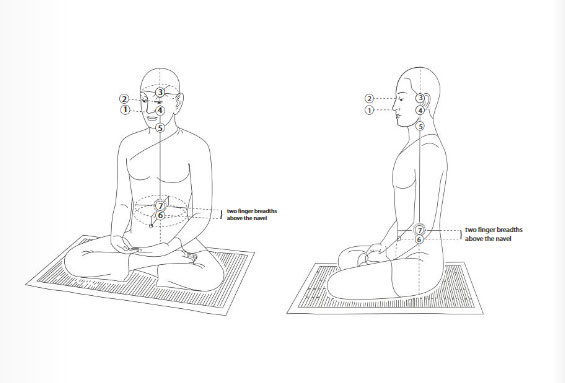
The Dhammakaya meditation method was initiated in Thailand almost 100 years ago by the Great Master Phramongkolthepmuni, famously known as Luangpor Wat Paknam. It is one of the most popular meditation techniques practiced by Buddhists and non-Buddhists around the world. The method is simple, easy, and effective. Everyone can learn how to do it and can achieve inner peace and happiness that you may never know existed.
"Dhammakaya" is a Pali word which means "Body of Enlightenment". The term appears in many places in the Buddhist scriptures of Theravada, Mahayana and Vajrayana (Tibetan) schools. The uniqueness of the Dhammakaya meditation is that it teaches about the center of the body as the natural home of the human mind as well as the inner gateway to enlighten-ment. The stiller the mind is at its natural home, the deeper the happiness one experiences.
Dhammakaya meditation also has a moral impact on the mind. A person who meditates regularly will become gentler, kinder, and more peaceful.
STEP-BY-STEP INSTRUCTION
1. The sitting posture, which has been found to be the most conducive for meditation, is the half-lotus position. Sit upright with your back straight, cross-legged with your right leg over the left one. You can sit on a cushion or pillow to make your position more comfortable. Nothing should impede your breathing or circulation. Your hands should rest palms-up on your lap, and the tip of your right index finger should touch your left thumb. Feel as if you were one with the ground on which you sit. Feel that you could sit happily for as long as you like.
2. Softly close your eyes as if you were falling asleep. Relax every part of your body, beginning with the muscles in your face, then relax your face, neck, shoulders, arms, chest, trunk and legs. Make sure there are no signs of tension on your forehead or across your shoulders.
3. Close your eyes gently but not completely. Stop thinking about any worldly things. Feel as if you were sitting alone; around you is nothing and no one. Create a feeling of happiness and spaciousness in your mind. Before starting, it is necessary to acquaint yourself with the various resting points or bases of the mind inside the body.
• The first base is at the rim of the nostril, on the right side for men and on the left side for women.
• The second base is at the inner corner of the eye, on the right side for men and on the left side for women.
• The third base is at the center of the head.
• The fourth base is at the roof of the mouth.
• The fifth base is at the upper center of the throat.
• The sixth base is at a point in the middle of your abdomen, the meeting point of animaginary line between the navel through the back and the line between the two sides.
• The seventh base of the mind is two finger breadths above the navel. This base is the most important point in the body. It is the very center of the body and the point where the mind can come to a standstill.
4. Feel that your body is an empty space, without organs, muscles or tissues. Gently and contentedly rest your attention at a point near the seventh base of the mind at the center of the body. Whatever experience arises in the mind, simply observe without attempting to interfere with it. This way, your mind will become gradually purer and inner experience will unfold.
5. If you find that you cannot dissuade the mind from wandering, then your mind needs aninner object as a focus of attention. Gently imagine that a bright, clear, crystal sphere, about the size of the tip of your little finger, is located inside at the center of the body. Maybe, you cannot imagine anything, but later, you'll be able to see a crystal ball with increasing clarity. Allow your mind to come to rest at the center of the crystal ball. Use the subtlest of effort and you'll find that the crystal ball becomes brighter and clearer.
6. If you find that your mind still wanders from the crystal ball, you can bring the mind back to a standstill by repeating the mantra, "Samma-arahang" silently, as if the sound of the mantra is coming from the center of the crystal ball. Repeat the mantra over and over again without counting.
7. Don't entertain thoughts in your mind. Don't analyze what's going on in the meditation. Allow the mind to come to a standstill. That is all that you need to do. If you find that you cannot imagine anything, repeat the mantra "Samma-arahang", silently and continuously in the mind. If you are not sure about the location of the center of the body, just know that anywhere in the area of your abdomen will do. Don't be disappointed if you find your mind wandering. It is only natural for beginners. Make effort continuously, keep your mind bright, clear and pure, and in the end, you will achieve success.
8. Keep repeating the mantra. Eventually the sound of the mantra will fade away. At that point a new bright, clear, crystal sphere will arise of its own accord. This stage is called "pathama magga" (primary path). At this stage the shining crystal sphere is connected firmly to the mind and is seated at the center of the body. You will experience a great happiness that you have never known before. With a perfectly still mind focused at the center of the crystal sphere, it will give way to a succession of increasingly purer transcendental inner bodies, until it reaches the "Body of Enlightenment" known as "Dhammakaya". This is the highest meditative attainment which enables the practitioner to achieve super knowledge and supreme happiness.